Lieven De BOECK, Let us be us, again and again, CC BRUGGE
Deconstructing and Reconstructing mind and
form, again and again
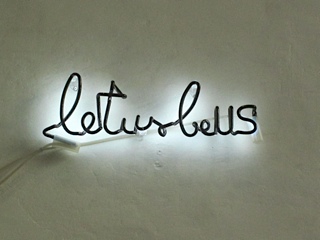
The current exhibition of Lieven de Boeck
(Brussels) in the Bogardenkapel is the first part
of a collaboration with the Fonderie Darling in
Montréal (Canada). The second exhibition will be
on show in september of this year.
In the Bogardenkapel de Boeck presents an
installation which combines new work created
during a residence at the CIRVA in Marseille 2012-
2013 and existing works which are representative
for the thoughts he develops in his oeuvre.
The thread in his work is a fundamental
questioning, a back and forth "sometimes subtle,
playful, sometimes very radical" between the
universal language of abstract forms and the more
detailed language of signs and words.
Generally his poetics can be seen as the poetics
of the recluse, the concealed and the hidden, and
this by means of the aesthetic use of the omission,
the copy paste, the covering.
This all led almost in a natural way to the use of
white as the predominant colour in his work.
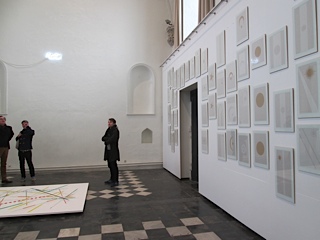
The idea for The white flags project arose during
his visit to the HQ of the United Nations in
New York in 2006.
As a reaction to the arbitrary alphabetic
arrangement of the flags according to their English
name, De Boeck introduced a playful order based
on their formal characteristics.
He identified 6 categories of motives (stripes,
crosses, circles, stars, moons and figures) and
classified them subsequently according to the
number of colours in the flag.
Afterwards the colours were erased by making the
flags from white semi-transparant paper.
In the process he used as many layers equal to the
erased colours.
Stripped from all colour and in a way purified
these national flags lose at first sight their original
function and peculiarity.
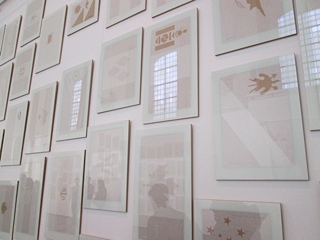
It is as if de Boeck removed all religious, historical
and ideological symbols and references, or, rather,
neutralises them. The forms are hollowed out
and remain visible, as if they are negatives or
footprints.
Thus his installation receives a spooky outlook
and his work symbolises the resistance against
any form of limitation of the identity and against
narrow minded nationalism.
He does not focus on the differences between
the symbolic constructions, on the contrary, he
emphasises on their resemblance.
At the same time the work can be seen as a
warning against the image of a joint identity which
leaves no space for peculiarity or diversity.
In that sense and as a symbol for the collaboration
between Cultuurcentrum Brugge and Fonderie
Darling, two new flags were made on actual
size : the flag of Québec hangs in Bruges and the
Flemish flag will be shown in Montréal.
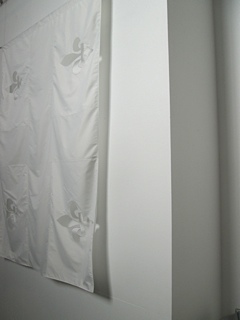
De Boeck created the installation Mikado LDB
Modulor in Marseille and it consists of 21 long,
fragile mikado bars made of blown glass. In
choosing this material he accentuates the fragility
and precarious balance of the deconstruction
or dismantlement which is associated with the
mikado game. While the previous work treated
the deconstruction of the identity, the present
work deals with a literal deconstruction.
This mikado extends another work which consists
of glass lego-cubes and which will be on show in
Montréal. Both projects are playful interpretations
of the phenomenon of building and dismantling.
They depart - which explains the term modulor
from the title - from the discovery that the
dimensions of the renowned plastic building
blocks are based on the Fibonacci sequence, a
mathematical set which lies amongst others at the
base of Le Corbusier modulor.
In Mikado LDB Modulor De Boeck uses the
Fibonacci sequence to determine the specific value
of each bar.
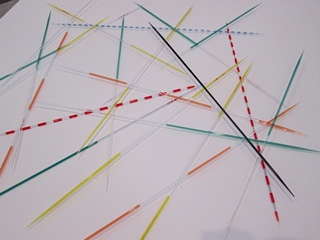
Both by the choice of materials or the unit of
length (instead of using the universal unit of
length "foot", he uses his own foot) De Boeck
questions with this work the impossible game
of the architect with the ideal dimensions in
architecture, and by extension the impossibility
to create the ideal man or mankind - something
which the organisations of the United Nations are
aspiring for.
Both projects refer to a fysical, material
or intellectual and cultural dismantling or
reconstruction. They make us reflect on the
relative, artificial and conventional character of
each form of representation and classification.
Hence we question in the end the conventional
parameters which tie us and which enable us to
develop ourselves in a spontaneous way.
This explains the title of the exhibition and
also the title of the third work of de Boeck : the
neonsculpture let us be us.
The caption refers - as in the other works -
to the idea of freedom, independence and
reconstruction. The illuminated words are
moreover painted in black, as if to show that
the manifestation of any form of questioning is
enhanced when the characteristics are reversed.
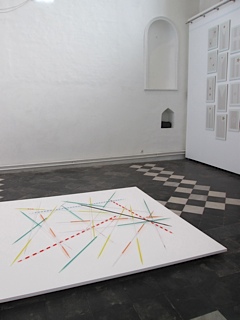
23.02.2014 - 14.04.2014
BOGARDENKAPEL, BRUGGE